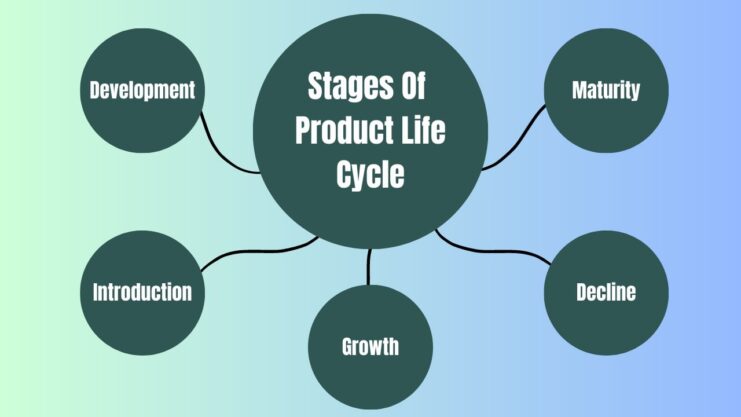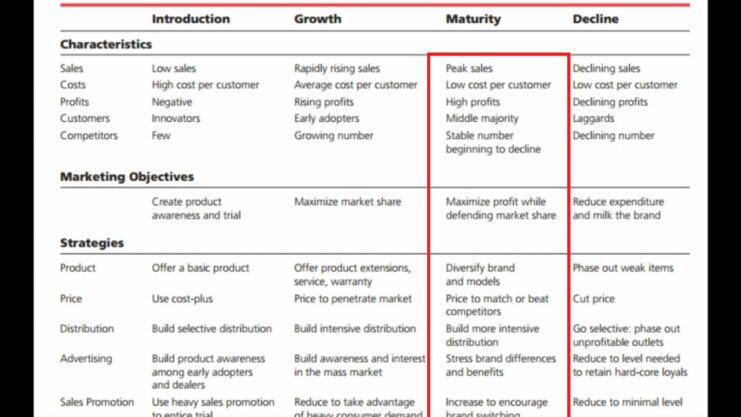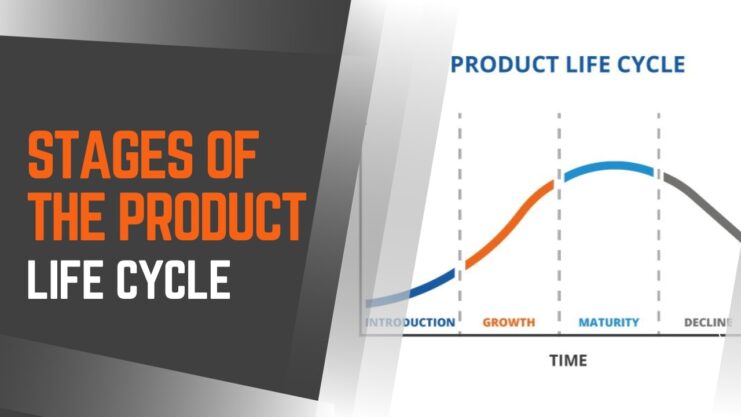As consumers, we buy millions of products annually, each of which has a lifecycle. As older products lose popularity, demand for newer ones usually increases rapidly.
Given that businesses comprehend the various stages of the product lifecycle and that the products they offer all have a finite lifespan, most of them invest extensively in developing new products to ensure their continued growth.
What is the Product Life Cycle?
The Product Life Cycle is the period of time from when a product is initially released to the public to when it is taken off the market. The cycle has four stages: introduction, growth, maturity, and decline.
Marketing and management professionals utilize this concept to determine when it is appropriate to adjust prices, increase advertising, expand into new markets, or redesign packaging. Product life cycle management is the process of strategizing ways to continuously maintain and support a product.
Similar to our amphibious friend, the frog, products go through multiple stages of development. The journey a product takes through these stages is what we refer to as its product life cycle. It starts when the product is first introduced to the market and ends when it is discontinued – whether in a physical or virtual store.
Every product line has its own distinct product life cycle. The entire process, including each stage, is not always consistent. Some products have longer lifespans than others, while others may seem to be stuck in a certain stage for an extended period of time. Additionally, some products may have short life cycles.
While understanding the importance of the product life cycle for business success, you may also want to explore the world of finance to help drive your company’s growth; take a look at our comprehensive guide on companies operating in the finance field to gain valuable insights.
5 Stages

After a product is created, it usually goes through the different phases of the product life cycle, which include introduction, growth, maturity, and decline, before eventually being taken off the market.
1. Development
The product development stage, which comes before the product life cycle, involves research to determine a product’s viability and when it should be launched. Costs may accumulate without corresponding revenue during this stage.
For certain products, development may take years and necessitate significant capital investment before they can be tested for effectiveness. As a result, external funding sources may be scarce. Businesses often fund R&D using revenue from their existing products.
It might be advisable for new product developers to create a minimum viable product (MVP) as soon as possible to demonstrate their product’s market potential to potential investors and customers. The sooner the product’s potential is validated, the more likely it is to receive investment and be launched.
2. Introduction
Once a product has been developed, the next stage in the Product Life Cycle (PLC) is the introduction stage. This is when the product is first released to the market. While this stage can be a critical time for the product, it does not necessarily determine the product’s long-term success.
During the introduction stage, the company invests a lot of resources and capital in marketing and promoting the product, as well as getting it into the hands of consumers. This is typically the period when advertising and promotion are at their highest, but it is also often a high-spending period for the company with no guarantee of sales.
3. Growth
The growth stage of the product life cycle begins once a product has been accepted by consumers, and the focus is now on expanding market share. During this stage, demand and revenue should increase at a steady rate.
The duration of this stage is influenced by various factors such as the product, the current market, and customer adoption rate. If you enter a crowded market, expect competition to respond quickly. If you enter a new industry with few competitors, you can expect a slower response. Regardless, it’s essential to fine-tune messaging, strengthen brand presence, and expand distribution channels.
This stage is also a good time to consider adding supplementary services to support and differentiate your product, such as support services, add-ons, and insurance packages. Having these options in place can help respond to competitors and extend ROI from each customer.
4. Maturity

Sales for a product tend to slow during the maturity stage, indicating a largely saturated market. The result is often a decline in sales, accompanied by price competition and shrinking profit margins.
Marketing during this stage is focused on avoiding competition, and companies frequently develop new or modified products to appeal to different market segments.
Due to the competitive market, weaker competitors are often pushed out during this period, known as the “shake-out point,” as sales volume peaks and the market becomes saturated.
To maintain or increase market share, companies frequently turn to innovation during the maturity stage. They may modify or develop products to meet the needs of new demographics or keep up with emerging technologies.
The duration of the maturity stage can vary greatly, depending on the product. For some products, like Coca-Cola (KO), the maturity stage can be lengthy and drawn out.
5. Decline
During the decline stage, the product’s sales and profitability begin to decrease as customers turn to substitute products that meet their needs more effectively. During this phase, several strategies can be employed to try and extend the product’s life:
One approach is to reduce marketing efforts and gradually limit distribution channels to keep the product on the market for as long as possible. This is referred to as “milking” or “harvesting” the product.
Alternatively, a company might remove the product from underperforming geographic areas and slowly phase it out.
Another strategy is to sell the product to a specialized operator or subcontractor, allowing the company to get rid of a low-profit product while keeping its loyal customers.
These tactics enable the company to withdraw the product and potentially introduce a replacement product.
Examples
From Typewriter, VCRs, and AI products to Electrical vehicles, there are many examples where we get to see the Product Life Cycle unfold:
Typewriters
Typewriters were first introduced in the late 1800s and quickly gained popularity as a tool for business and personal correspondence. During the growth stage, typewriters became widely adopted and their sales increased rapidly.
However, with the introduction of computers in the 1980s, typewriters entered the maturity stage, where sales began to decline. By the 2000s, typewriters had largely been replaced by computers and other digital devices, and entered the decline stage where they are now only used by a small niche market.
Electrical Vehicles
Electric vehicles are a relatively new product, with companies like Tesla (TSLA) capitalizing on growing demand. However, recent challenges may signal a shift in their strategy. While electric cars have been around for some time, the recent innovations by Tesla and other companies suggest that the product is still in its early stages.
AI products have been in development for several years, but the industry is continuously advancing and creating new products that are approaching the introduction stage of the Product Life Cycle.
Current AI products, such as self-driving cars and AI-infused sex robots, are still being developed and tested, and those that have already been released to the market are still in their early stages of adoption and growth.
VCRs
The VCR (videocassette recorder) was once a staple in households for watching movies and recording television shows, but with the advent of streaming services like Netflix and Amazon, VCRs have become obsolete and are now in the final stages of the product life cycle.
Real Examples of Product Life Cycle
Coca Cola
Coca-Cola, one of the world’s most well-known and long-standing brands, has gone through various stages of the product life cycle:
- Development: The origins of Coca-Cola’s formula are shrouded in mystery, with little information available about its creation process.
- Introduction: Coca-Cola was first introduced in 1886, and within a decade, it had gained popularity across all 50 states in the U.S.
- Maturity: It’s difficult to determine precisely when Coca-Cola reached maturity, but it has arguably spent the majority of its history in this stage, with a well-established market share and loyal customer base.
- Decline: Coca-Cola’s revenue has been declining since 2012, which is expected during the maturity stage. However, the company must continue to invest in marketing and new products to maintain its market position and extend the product life cycle.
Havaianas
Havaianas is a brand of flip flops that originated in Brazil and is now sold globally. The product life cycle of Havaianas can be summarized as follows:
Development: Havaianas were developed in the mid-20th century, inspired by traditional Japanese sandals. Rubber was chosen as the material, which proved to be popular with Brazilian consumers.
- Introduction: Havaianas were initially marketed to lower-income consumers in Brazil and quickly gained popularity.
- Growth: The brand experienced significant growth, eventually dominating the flip flop market with over 90% market share.
- Maturity: In the 1990s, Havaianas introduced new product designs aimed at different audiences and invested heavily in marketing, including iconic TV commercials featuring famous actors. The brand has since achieved maturity and shows no signs of decline.
Factors Affecting the Product Life Cycle
The product life cycle is affected by a variety of factors, including competition, consumer demand, technological advances, and economic conditions. These factors can impact each stage of the product life cycle and can ultimately determine whether a product succeeds or fails.
Competition plays a significant role in the product life cycle. When a product is first introduced, there may be little competition, and the product can quickly gain market share.
However, as more competitors enter the market, the product may struggle to maintain its position. This can lead to price wars and reduced profits, which can ultimately lead to the product’s decline.
Consumer demand is another critical factor in the product life cycle. When a product is first introduced, it may be in high demand, leading to a period of rapid growth. However, as the market becomes saturated, demand may begin to decline, leading to a period of maturity or decline.
Understanding consumer demand and trends is essential in developing products that will be successful throughout their life cycle.
Technological advances can also affect the product life cycle. As new technologies are introduced, products that were once in high demand may become obsolete. Companies that fail to adapt to changing technologies may find themselves struggling to maintain their position in the market.
On the other hand, companies that are quick to adopt new technologies may gain a competitive advantage, allowing them to extend the life cycle of their products.
Economic conditions can also impact the product life cycle. During times of economic downturn, consumers may be less willing to spend money on non-essential items, leading to a decline in demand for certain products. Similarly, changes in exchange rates, interest rates, and inflation can also impact the demand for products.
In addition to these external factors, internal factors such as pricing, distribution, and marketing strategies can also affect the product life cycle. Companies that are able to adapt and respond to changing market conditions are more likely to succeed throughout the product life cycle.

